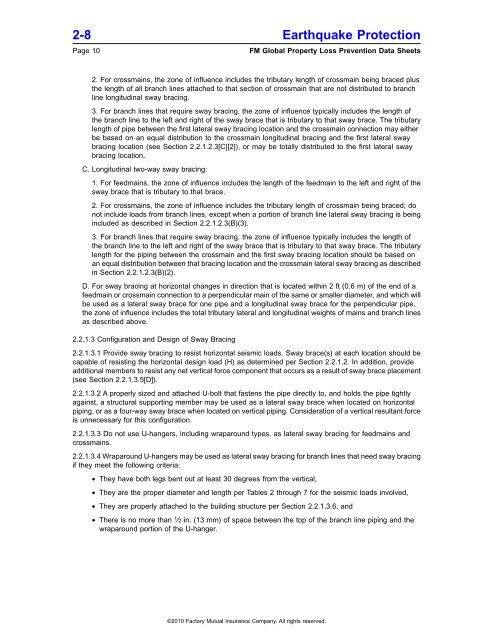DS 2-8 Earthquake Protection for Water-Based Fire ... - FM Global
DS 2-8 Earthquake Protection for Water-Based Fire ... - FM Global
DS 2-8 Earthquake Protection for Water-Based Fire ... - FM Global
You also want an ePaper? Increase the reach of your titles
YUMPU automatically turns print PDFs into web optimized ePapers that Google loves.
2-8 <strong>Earthquake</strong> <strong>Protection</strong><br />
Page 10 <strong>FM</strong> <strong>Global</strong> Property Loss Prevention Data Sheets<br />
2. For crossmains, the zone of influence includes the tributary length of crossmain being braced plus<br />
the length of all branch lines attached to that section of crossmain that are not distributed to branch<br />
line longitudinal sway bracing.<br />
3. For branch lines that require sway bracing, the zone of influence typically includes the length of<br />
the branch line to the left and right of the sway brace that is tributary to that sway brace. The tributary<br />
length of pipe between the first lateral sway bracing location and the crossmain connection may either<br />
be based on an equal distribution to the crossmain longitudinal bracing and the first lateral sway<br />
bracing location (see Section 2.2.1.2.3[C][2]), or may be totally distributed to the first lateral sway<br />
bracing location.<br />
C. Longitudinal two-way sway bracing:<br />
1. For feedmains, the zone of influence includes the length of the feedmain to the left and right of the<br />
sway brace that is tributary to that brace.<br />
2. For crossmains, the zone of influence includes the tributary length of crossmain being braced; do<br />
not include loads from branch lines, except when a portion of branch line lateral sway bracing is being<br />
included as described in Section 2.2.1.2.3(B)(3).<br />
3. For branch lines that require sway bracing, the zone of influence typically includes the length of<br />
the branch line to the left and right of the sway brace that is tributary to that sway brace. The tributary<br />
length <strong>for</strong> the piping between the crossmain and the first sway bracing location should be based on<br />
an equal distribution between that bracing location and the crossmain lateral sway bracing as described<br />
in Section 2.2.1.2.3(B)(2).<br />
D. For sway bracing at horizontal changes in direction that is located within 2 ft (0.6 m) of the end of a<br />
feedmain or crossmain connection to a perpendicular main of the same or smaller diameter, and which will<br />
be used as a lateral sway brace <strong>for</strong> one pipe and a longitudinal sway brace <strong>for</strong> the perpendicular pipe,<br />
the zone of influence includes the total tributary lateral and longitudinal weights of mains and branch lines<br />
as described above.<br />
2.2.1.3 Configuration and Design of Sway Bracing<br />
2.2.1.3.1 Provide sway bracing to resist horizontal seismic loads. Sway brace(s) at each location should be<br />
capable of resisting the horizontal design load (H) as determined per Section 2.2.1.2. In addition, provide<br />
additional members to resist any net vertical <strong>for</strong>ce component that occurs as a result of sway brace placement<br />
(see Section 2.2.1.3.5[D]).<br />
2.2.1.3.2 A properly sized and attached U-bolt that fastens the pipe directly to, and holds the pipe tightly<br />
against, a structural supporting member may be used as a lateral sway brace when located on horizontal<br />
piping, or as a four-way sway brace when located on vertical piping. Consideration of a vertical resultant <strong>for</strong>ce<br />
is unnecessary <strong>for</strong> this configuration.<br />
2.2.1.3.3 Do not use U-hangers, including wraparound types, as lateral sway bracing <strong>for</strong> feedmains and<br />
crossmains.<br />
2.2.1.3.4 Wraparound U-hangers may be used as lateral sway bracing <strong>for</strong> branch lines that need sway bracing<br />
if they meet the following criteria:<br />
• They have both legs bent out at least 30 degrees from the vertical,<br />
• They are the proper diameter and length per Tables 2 through 7 <strong>for</strong> the seismic loads involved,<br />
• They are properly attached to the building structure per Section 2.2.1.3.6, and<br />
• There is no more than 1 ⁄ 2 in. (13 mm) of space between the top of the branch line piping and the<br />
wraparound portion of the U-hanger.<br />
©2010 Factory Mutual Insurance Company. All rights reserved.

















